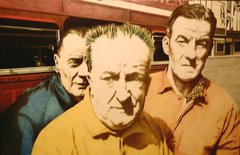
Look past fall’s cool breeze, the new smiles of freshman friendship and those white swings rocking the soon-to-be-engaged, and you’ll see something often overlooked on Harding’s campus – civil war. Both sides of the battle are demanding resolution, leading to graffiti on bathroom stall to Facebook wall. This age-old issue has baffled philosophers since the beginning of time: Are we the Harding Bison or the Harding Bisons?
Inconsistencies in our newspaper, sports teams and t-shirts (featuring the buffalo that resembles a bowling ball with horns) have stirred a long debate over the word ‘Bisons’ being grammatically incorrect. However, while most dictionaries don’t recognize it, ‘Bisons’ can be a rare plural form of ‘Bison’. But try typing ‘Bisons’ on Microsoft Word and you’ll be met with an obnoxious red line that pierces the school-spirit. Before I offer my exotic solution, consider other schools in Harding’s Division II Gulf South Conference.
The GSC contains the most delightfully random mascots in the NCAA: the Monticello “Boll Weevils” and “Cotton Blossoms”, Ark. Tech’s “Wonder Boys” and “Golden Suns”, Southern Ark.’s “Muleriders”, Delta State’s “Fighting Okra” and Western Fla.’s “Argonauts”—a mythical group of bitter Greek sailors. With the generic “Bisons”, we join eight other universities (including that other Church of Christ school in Nashville) struggling with 2,000 hairy pounds of plurality problems. Since 1924, we’ve never been afraid to ask, “Can Harding do better?” So imagine this scene: It’s homecoming 2007 and instead of a bison charging the field endangering cheerleaders and journalists, one brave soul gallops out on Harding’s new and improved mascot—the Zeedonk.
Just four miles from First Security Stadium, a Kensett man owns “Trouble,” Arkansas’ only known zeedonk. Before you log onto snopes.com to crosscheck this with urban legends, drive to the corner of Searcy and 4th street. It’s impossible to pass the extremely rare hybrid between a zebra and a donkey without staring at the striped socks on his brown body. Also known as the zebronkey, zonkey, zebadonk, zenkey, zebrinny, deebra and, my personal favorite, zebrass, the animal gained national attention on Jay Leno’s “Headlines” when he mistakenly corrected a carnival for advertizing “zonkies.”
The Thundering Herd Marching Band will become the “Prancing Zebrinnies,” and other improvements will follow. What better time to correct the Bison/Bisons debate? Harding has new programs starting, a new head football coach, record enrollment, and a new international program in Zambia—which has real zebras. At a university that highly values staying up-to-date on current technologies and resources, it’s time to move on from the bison—a species that hasn’t run wild in White County in nearly 200 years. The close proximity of an actual oat-eating zeedonk is unique and far exceeds the nearest buffalo—living in the Ozarks on a ranch called “Happy Buffy” where they are happily sold between hamburger buns.
With modern emphasis on shock value, much like in this article, the Harding Zeedonks are sure to be a YouTube sensation. After visiting with the local owner in Kensett last weekend, he told me of the radio and television stations interested in “Trouble.” The Montel Williams Show has even contacted him for a segment on wacky animals—the ultimate dream for every mascot. And with the new Zaxby’s Chicken coming to Searcy, they can have an employee stand on Race Street dressed as a zeedonk in a firework-proof suit. The children will love that.
Until then, who are we? Among students, there is usually a stronger connection with the squirrels on the front lawn than the unseen bisons. Watching football on Saturdays, I see (often freakish) devotion to mascots and school-spirit around the country. Is this possible at Harding? Obviously Harding’s emphasis on athletics is prioritized differently than at public universities, but should football school-spirit improve? We are 6,332 with a spiritual bond that is nearly as unique as the cross between a zebra and a donkey—how are we going to show it?


1 comment:
This is nice information blog. Thanks for Sharing.
Post a Comment